Detection of drains in the GLONASSSoft system
Fillings and drains are determined according to the "Refill" and "Drain" event templates.
Fuel drain is a measure of fuel reduction, determined under the conditions that during a STOP (location did not change more than 30 m and the speed was less than 6 km/h) there is a change in fuel level over a period of more than 40 seconds by 10+% of capacity tank (this value is calculated in accordance with the calibration table of the sensor, while values less than the first and greater than or equal to the last line are considered invalid and ignored). An event can be recorded only if there are coordinates from the device.
Conditions are set by default and can be edited individually. In this case, the system does not record events that do not fall within the specified range of conditions. The choice of conditions can have a large impact on the reliability of events.
You can identify fuel drains in the system using the “Templates” tab . To go to this tab, you need to select the required object in the system. And click on the "Edit" button.
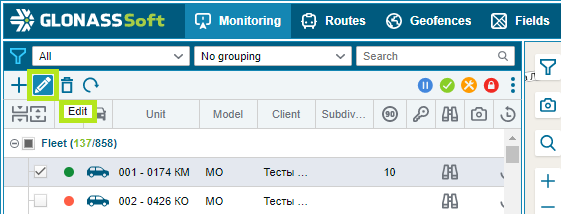
Next, an editing window will open with the “Templates” tab.
This tab is intended for editing event templates, which should be triggered by the sensors installed in the object's equipment.
When creating a fuel level sensor, the "Drain" template will appear.
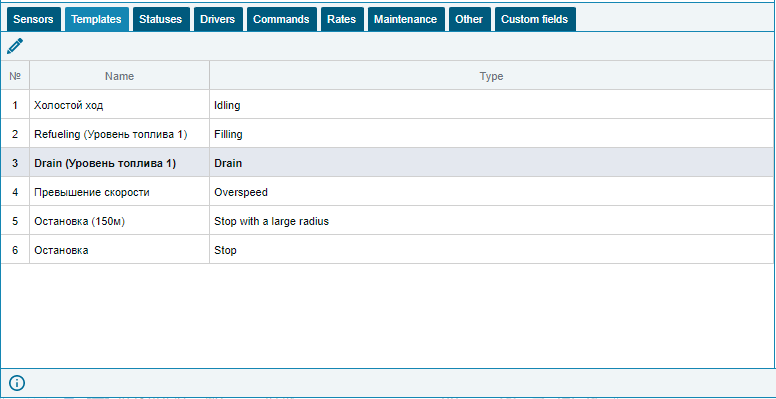
By going to it, we will be able to edit its conditions.
The standard drain conditions are the presence of events:
Stop (150m) - the presence of this condition allows you to search for drains only when the equipment is stopped / parked. Due to this, the system does not display fuel drains at the moments of fuel surges during the trip. If you need to look for plums on a trip, then remove this condition.
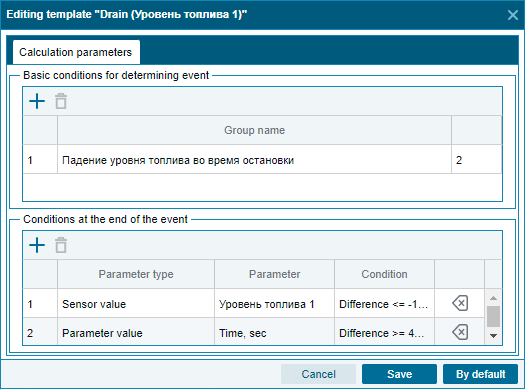
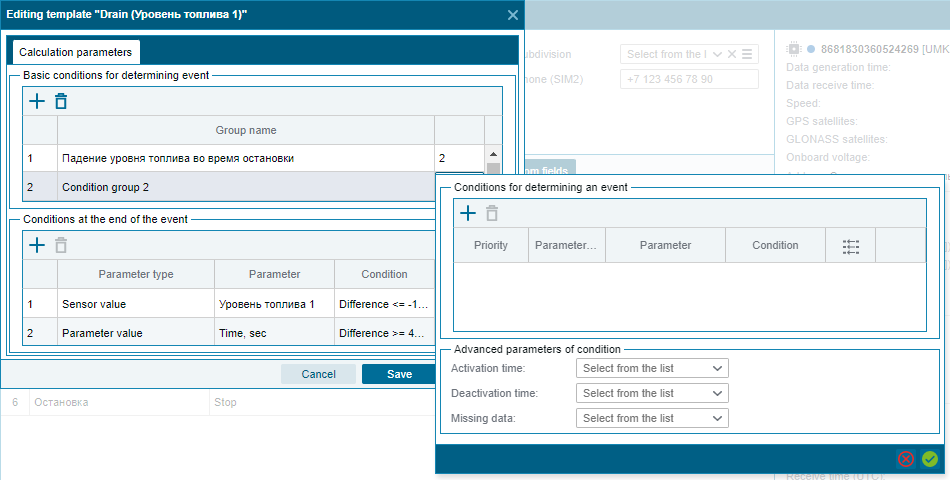
"Flow more than 0 units/sec" - the default value is zero. Thus, any rate of fuel consumption begins to be analyzed by the system. If you have disabled the Stop (150m) condition and you have false drains during the trip, then adjusting the “Consumption is more than 0 units/sec” condition will help get rid of them. Specify a value greater than zero, such as 0.01 which equals a flow rate of 600 ml/min or 18 l/h, and you will get rid of false drains.
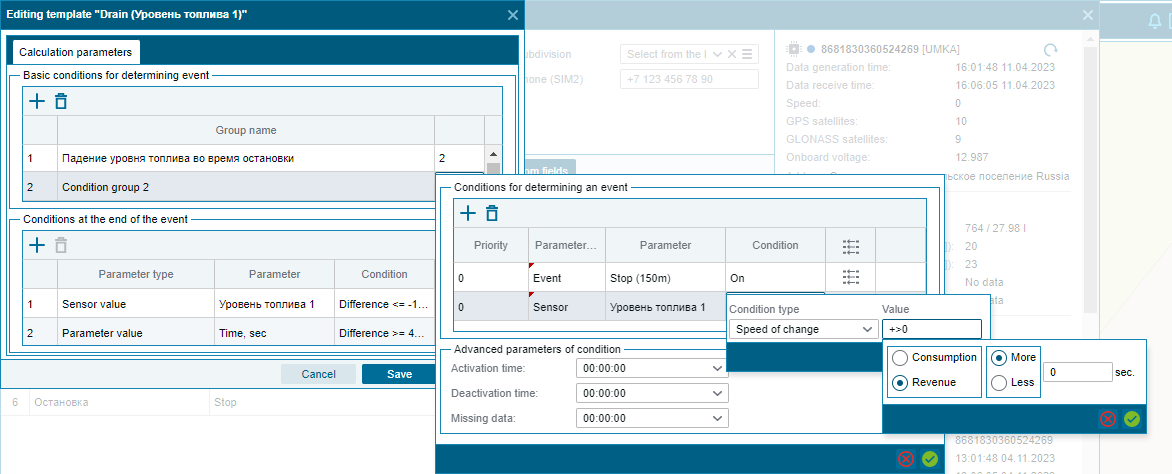
The activation time allows you not to start calculating the drain immediately, as soon as the rate of change in fuel consumption exceeds the specified value, but after the specified time. Changing this value can also help eliminate false drains.
The deactivation time allows you to continue searching for an event that satisfies the condition for changing the fuel consumption rate, for some time after the change in the fuel consumption rate below the specified value. If the drain occurs unevenly, then this parameter allows you not to interrupt the drain event and continue to search further for fuel consumption that falls under the drain conditions.
By default, draining is considered perfect if fuel consumption has occurred by 10% or more of the tank volume specified in the calibration of the fuel level sensor. This condition can also be changed by specifying a smaller percentage of the tank volume or by specifying a difference in liters.
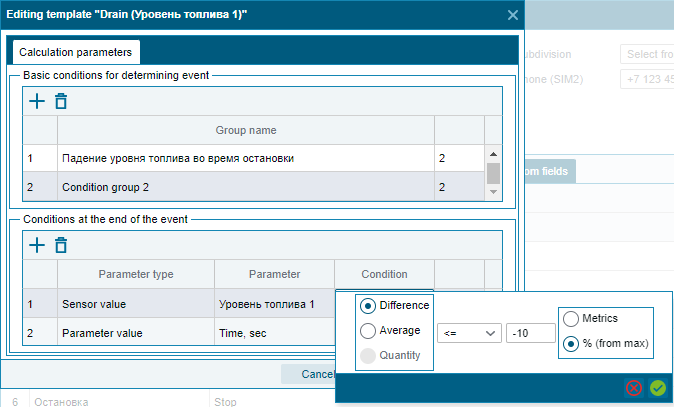
Also, the duration of the drain affects the registration of the drain. By default, a drain is considered perfect if it lasted 40 seconds or more. This value can also be set individually.
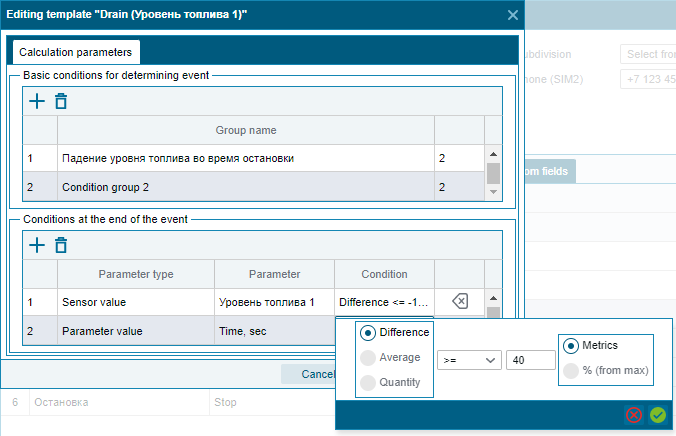
Estimate the volume of the drain - if it is larger than the canister, then assess whether such a drain could be caused by repair work or some operations to transfer fuel from one car to another, etc. If plums are repeated, do they have a pattern? For example, the driver always pours 10 liters into the canister in the morning or in the evening, in certain places, etc.
Estimate a drain by duration - Drains can be conditionally divided into several types, the easiest way is to evaluate them by the time of the event.
Time from 1 sec to 2 minutes:
- can be caused by fuel fluctuation (fuel level dropped sharply and returned to its original state. Associated factors: sharp turn, braking, overtaking on the side of the road).
- may be a small drain at a stop (the fuel level dropped sharply, after which it remained unchanged. Contributing factors: the driver poured the fuel into a bottle or small canister). Please note that short stops are not always displayed, the default stop is over 300 sec.
Time from 2 to 10 minutes:
this is the most popular drain time for drivers.
- it may be a drain at a stop - the fuel level gradually decreased, after which it remained unchanged. Related factors: the volume of a classic canister, exit from the road, parking, monotonous time.
- may be fluctuating - the fuel level has slowly decreased and returned to its original state (overflow inside the tank). Contributing factors: the road is uphill, standing in a traffic jam at the junction, parking with a wheel on the curb.
Time from 10 minutes and more:
- can be a drain at a stop with the equipment turned off (the mass of the vehicle is turned off). For example, for this category, a nightly drain of fuel takes place - in the evening they turned off the mass, turned it on in the morning (for example, it was at 18.00 in a tank of 100 liters, 20 liters were drained, in the morning at 6.00 a drain will be displayed with a duration of 12 hours and a volume of 20 liters - there will be a straight line on the drain chart , from one point to another). Such plums can only be seen if you build 2 days or more (evening-night of the first day / morning of the second). Additionally, you need to make sure that the location of the machine at the beginning and end of the drain has not changed.
- can be the real fuel consumption for the period that is lost. The situation is similar to the previous one, except that at the beginning of the drain the car was in one place on the map, and at the end it ended up in another. For example, if the terminal has lost satellites or has been de-energized, while the car is moving and fuel consumption occurs. The system will display this fuel difference as a drain as soon as the terminal is able to measure the new fuel level and compare it with the old one. If a straight line of a distorted track is displayed on the map (cut, shot), you can estimate the distance between the cut points with the Measure tool (ruler - allows you to measure the track segment on the map). If the distance is significant, the time and volume of the drain allow you to correlate the mileage, time and consumption, then it is concluded that this is not a drain, but the actual fuel consumption.
- it can be a drain from the return line or simply an overestimated flow rate (for example, the operation of additional equipment - the monitoring shows a uniform decrease in fuel at approximately the same rate. There are no sharp drops in fuel, however, the rate of fuel drop significantly exceeds the threshold value of the Drain event template (decrease in liters / sec) It is necessary to pay attention to the following things:
1. whether the drop occurs only at speed or the overestimated fuel consumption continues at stops at idle. is it possible for this type of transport at stops or the driver forgot to turn off the tap on the return fitting and the fuel level decreases linearly and there is no way to explain this?
2. Is there a reasonable explanation for this expense? Unit operation (pump running, mower running, driving at high speed, transporting goods, vehicle malfunctioning, etc.) Is the vehicle in good condition?
the machine performs the same tasks, if the machine has done this operation before, are there days where the overestimated consumption was not displayed? The release of the report Fuel with subsequent analysis of consumption by day, will give an understanding of the basic consumption in fact.